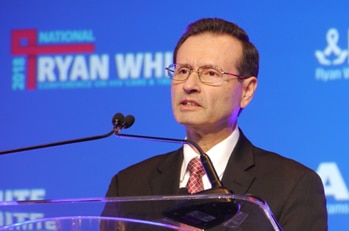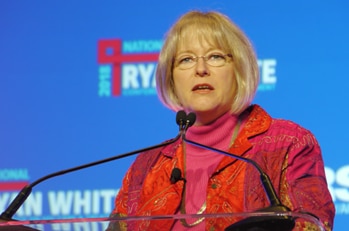2018
2018 National Ryan White Conference Highlights Data and Innovation to End the HIV Epidemic
Approximately 4,000 HIV healthcare providers, HRSA’s Ryan White HIV/AIDS Program recipients and subrecipients, partners, people living with HIV (PLWH), other stakeholders, and members of the general public gathered for the 2018 National Ryan White Conference on HIV Care & Treatment. The biennial event, hosted by the Health Resources and Services Administration’s (HRSA) HIV/AIDS Bureau (HAB), was held December 9–14, 2018, at the National Harbor in Oxon Hill, Maryland. The National Ryan White Conference’s theme was “Catalyzing Success: Advancing Innovation. Leveraging Data. Ending the HIV Epidemic.”
The National Ryan White Conference’s primary goals were to learn and share best-practice models and strategies that reduce new HIV infections; expand access to high-quality, life-extending HIV care and treatment without stigma or discrimination; reduce HIV-related health disparities; and improve HIV treatment outcomes. The National Conference consisted of six session tracks, four plenaries, 240 presentations, and nearly 200 poster sessions. Many of the presentations demonstrated how recipients of HRSA’s RWHAP are working within their communities to catalyze innovative strategies and models of care to improve and integrate engagement, services, and treatment for PLWH across the HIV care continuum. The continued implementation of these effective models and strategies supports the goal of HRSA’s RWHAP to end the HIV epidemic.
U.S. Department of Health and Human Services Secretary Alex Azar and HRSA Administrator Dr. George Sigounas delivered powerful messages about the success of the Ryan White HIV/AIDS Program. HHS Secretary Azar shared that the “frontlines of the fight against HIV” are where Ryan White HIV/AIDS Program recipients work every day, and he thanked attendees for their dedication to this challenge. Dr. Sigounas noted that RWHAP recipients “are the local, state, and national leaders translating the latest science into practice, providing direct patient services, and using data to drive services and deliver HIV care.” He concluded by observing that there are a significant number of people “who are out of care and undiagnosed who need our care and support.” Dr. Anthony Fauci, Director, National Institute of Allergy and Infectious Diseases, ended the plenary session on the National Conference’s opening day by emphasizing the advances that have been made in HIV care and that the results within the RWHAP are unprecedented.
As the 2018 National Conference continued, other plenary sessions highlighted how Ryan White HIV/AIDS Program recipients leverage data and innovative tools to improve models of care and address populations who face disparities, including individuals with undiagnosed HIV and those not receiving HIV care and treatment.
During the biennial event, the Annual Client-Level Data Report: Ryan White HIV/AIDS Program Services Report, 2017 was released. The report features Ryan White HIV/AIDS Program Services Report (RSR) data about all clients served by the RWHAP during calendar years 2013 through 2017. The publication provides an in-depth look at demographic and socioeconomic characteristics of RWHAP populations served, including age, race, ethnicity, transmission risk category, federal poverty level, health care coverage, and housing status.
To kick off the opening plenary, Dr. Laura Cheever, Associate Administrator for HRSA HAB, provided a “first look” at the latest data, including continued improvement in viral suppression among RWHAP clients. In 2017, 85.9 percent of RWHAP clients who received medical care for HIV were virally suppressed, up from 69.5 percent in 2010. Dr. Cheever also highlighted that—
- The demographics of RWHAP are changing. People are living with HIV longer, and those who comprise a greater proportion of those receiving RWHAP services are aged 45 years and older—around 60 percent—or a 10 percent increase from 2010.
- Disparity gaps have been reduced markedly with across-the-board improvements in viral suppression across states, racial/ethnic populations, gender, and age groups.
- Despite progress, disparities persist, particularly in southern states.
 Health Resources & Services Administration
Health Resources & Services Administration




